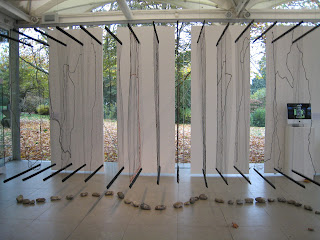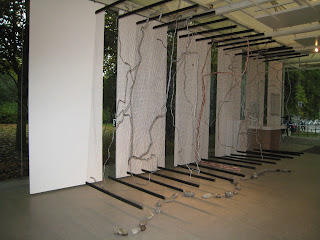Saturday 27 October 2012
Transparent boundaries: the colloquium
This colloquium at the Farnham UCA campus brought together the Transparent boundaries project participants and others working with ‘Elders’. Mary Schoeser spoke about the role of Elders in shaping contemporary textiles and brought a preview copy of her new book ‘Textiles: the art of mankind’ which is a sumptuous volume packed full of colour photographs of textiles; it is published next week. Fiona Davies explained the ideas behind her exhibition ‘Blood on Silk’ which is currently showing in the Hockey Gallery, Farnham (I’ll review it next week). The work is part of a series of installations produced as a response to her father’s last illness and exhibited in his local church in Aberdeen, Australia, and Lincoln College, Oxford, where he studied as a young man.
The European participants from the Transparent boundaries project then described their projects, details of which can be found on the website, but which are all linked by lacemaking. Gail Baxter and I are the lead artists for the UK pilot project, which is based on lace and mapping, and together with Dee Brien, the coordinator of the group we’ve been working with, we described how we produced ‘Tracks’ the lace installation currently being exhibited in the Foyer Gallery, Farnham (see my previous post Transparent boundaries: tracks). The day ended with Tony Docker telling us about an initiative for older people based on the Duke of Edinburgh scheme and, the artist, Bob White talking about the works produced by artists such as Goya, Titian and Rembrandt in their old age and how they differed from their earlier paintings. It was an interesting day that brought together many people interested in textiles and lace and their use in contemporary art.
Tuesday 23 October 2012
Transparent boundaries: Tracks
Tracks is an installation currently being exhibited in the Foyer Gallery, UCA, Farnham. It is the first part of a project Gail Baxter and I are involved in as part of the Transparent boundaries project. Transparent boundaries is an EU project including partners from the UK, Denmark, Greece and Italy, the aim of which is to increase the visibility of the Elder using lace networks. Gail and I are the lead artists for the UK and have been running a series of workshops with a group of Elders to produce this installation and other pieces which are being exhibited to coincide with the first conference linked to the project on Friday 26 October. All the members of the UK Elders group were asked to map their movements on one day in September and from this data simple line maps were generated that could be depicted by threading a silver thread through garden mesh to mimic filet lace. We have held several workshops with the Elders at which information has been shared and they have produced the ‘lace’. It has been quite a challenge to produce a lace installation that is visually interesting, inclusive of all the participants, and suitable for those who do not necessarily have any needlework skills. More projects, workshops and conferences are planned for the UK and the other EU partners and you can see more about the entire project on the Transparent boundaries website.
Sunday 21 October 2012
Nao Fukumoto at Air 3
Nao Fukumoto is taking part in this exhibition at the Crafts Study Centre, Farnham, showing the work of some of the artists in residence at nearby UCA. Nao’s hand woven and natural dyed textiles are being exhibited in the stairwell. I liked the way these shawls were finished with a few wrapped tassels and button fasteners making them easy and versatile to wear. Two other examples of Nao’s work are ikat dyed and woven, blue and white textiles incorporating subtle squares of contrasting colours. All the pieces are beautifully made and subtly coloured. I only had time for a flying visit and particularly wanted to see Nao’s work. I’m hoping to visit the exhibition again to see the work of the other artists.
Thursday 11 October 2012
Framing space
I’ve just returned from hanging the Framing space exhibition at Artworks, Milton Keynes. Four of us (Gail Baxter, Sue McLaggan, Carol Quarini, Beth Walsh) are exhibiting work that has developed from lace and lacemaking under the joint name Liminal. I’m showing one of my Whispering series of net curtains (see the image above), which is hung appropriately in front of narrow, cobwebbed, gothic windows, perfectly placed to allow the curtains to re-read the domestic. Gail’s cubes of interlinked threads and paper fibre, inspired by the layers and lacunae of archives hang beside my curtains. Entitled ‘Reading shadows’, the work is designed to be lit from several angles to reveal yet more layers to the work. Gail is also showing Mediation which includes multilayered bobbin lace hangings linked to her research into museum collections and I am also showing images from my Embedded memories series.
Sue is showing several of her beautiful neckpieces. Designed as wearable pieces they also reference the way in which clothes and accessories are used to reveal or conceal the wearer’s identity and feelings.
Beth is showing several pieces including the series shown here entitled Soundscapes. The twelve bobbin lace vignettes are combined with the sounds of the sea recorded on the coast at Sheringham, Norfolk, over the span of a year. The evocative sounds are designed to be heard through headphones as the visual record of the year is contemplated through the lace.
The exhibition runs until 3 November and there are workshops, talks and meet the artist days throughout that time.
Monday 8 October 2012
The yellow wallpaper
This exhibition at Danson House references the novella of the same name by Charlotte Perkins Gilman. Curated by Tom Gallant, it contains his ‘Dress 09’ based on the story of the yellow wallpaper and complementary works by five other artists linking to Victorian culture. The novella is based on a rest cure for a Victorian woman, which requires her complete isolation in a bedroom decorated with yellow wallpaper, and describes her descent into madness as she sees a figure like herself trapped behind the wallpaper and attempts to tear the paper down to help the prisoner escape. Tom Gallant’s intricate wallpaper ‘Iris’, inspired by a William Morris pattern and containing images of all seeing eyes, and his ‘Dress 09’ both reference the novella directly. The dress, constructed in collaboration with Marios Schwab, is made of laser cut corded silk over painted silk crepe and cleverly reproduces the effect of the top layer gradually peeling away from the underlayer. The false shadow, by forming a layer of shed skin, also adds another dimension of unreality.
Two of the artists had produced site specific work for this exhibition. Fiona Curran had laser cut plywood to produce oversized wall patterns. Based on an 18th century floral silk pattern, she had embellished them with icing sugar to reference the origins of the Boyd family fortune (A delicious garden, 2011).
Ligia Bouton had combined comic book images of a superhero and Victorian wallpaper to produce an installation including images of the hero taking on ‘an army of furniture monstrosities which embodied the excesses of Victorian furniture’. This work ‘The adventures of William Morris man’ particularly resonated with me because Ligia’s anthropomorphic use of furniture has links with the way I use net curtains to comment on the domestic. As a whole, the exhibition also included furniture, photography and animation and many layers of interest, all in a gem of a venue at Danson House.
Tuesday 2 October 2012
Art of change: New directions from China
This interesting exhibition of installation art at the Hayward explores ideas of transformation and impermanence. All the artists are Chinese and most of them have become used to producing impermanent works of art, which are often closed down by the authorities, or developing performance or interactive art that can be performed anywhere. When you enter the exhibition you are confronted by Xu Zhen’s Untitled, an exercise machine that you are invited to operate by remote control involving no effort at all. Another witty piece by the same artist is Just a blink of an eye showing someone half way through falling (see the image above). To experience Happy Yingmei by Yingmei Duan you had to stoop through a tiny door to enter a grotto of twigs forming a little forest where the artist spoke poetry to you. It was quite dreamlike and intense because it was so personal. It says in the catalogue that she ‘chose to become an artist because it did not require her to speak’ which seemed strange as she was the only artist in the exhibition actually speaking. Her other piece in the show was a performance in which actors interacted with shelves on the wall, which reminded me of Francesca Woodman’s photographs.
Having made silk paper for many years I was fascinated by Liang Shaoji’s work which is all based on silkworms, apparently the silkworm symbolises generosity and its thread represents human life and history. His Nature series allows the silkworms to produce their silk on Chinese lattice windows, stones, small iron beds made by the artist and large ‘chains’ hanging from the ceiling – although I think the worms had some help in placing their silk. The lattice windows in particular were beautiful. In an installation to the side of this room there are four round trays of silkworms at various stages of their life cycle with tiny microphones on each tray; when you enter the second room you can put on headphones to hear the sounds from the different trays. Outside the room are three round panels of silk threads produced by the worms. The whole installation was quite meditative.
The exhibition shows the work of nine artists; those I’ve described are just my favourites. So there is plenty to see and also a digital archive of their previous installation work if you still want more.
Subscribe to:
Posts (Atom)










